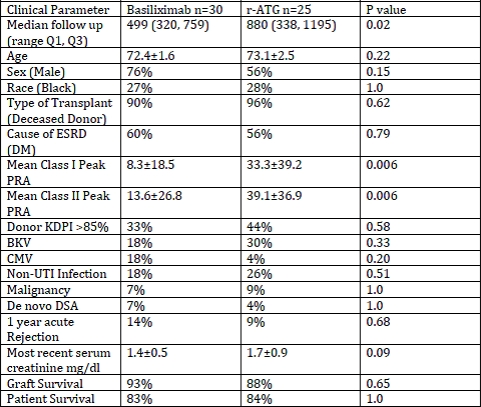Effect of Induction in Renal Transplant Recipients Aged 70 and Over
Transplantation, Montefiore Medical Center, Bronx, NY.
Meeting: 2015 American Transplant Congress
Abstract number: A162
Keywords: Elderly patients, Induction therapy, Kidney transplantation
Session Information
Session Name: Poster Session A: Kidney Immunosuppression: Induction Therapy
Session Type: Poster Session
Date: Saturday, May 2, 2015
Session Time: 5:30pm-7:30pm
 Presentation Time: 5:30pm-7:30pm
Presentation Time: 5:30pm-7:30pm
Location: Exhibit Hall E
While there is a significant survival advantage to transplanting patients 70 years of age and older versus staying on dialysis, it is unclear whether sensitized elderly transplant recipients who receive potent induction therapies are at a greater risk for infection or other adverse outcomes.
We performed a single center, retrospective cohort analysis of kidney-only transplant recipients 70 years of age and older transplanted between 4/2009 and 10/2014. Repeat transplants, patients with peak PRA >20% and/or patients with DSA at the time of transplant received induction with rabbit anti-thymocyte golubin induction (r-ATG), n=25. All other patients received basiliximab, n=30. Primary outcomes assessed were graft and patient survival and secondary outcomes included 1-year acute rejection and non-UTI infectious complications.
Mean age at transplant was 72.3±2.1 years (range 70-78) and median time on dialysis was 2 years (range 0-10 years). Death censored graft survival was 91% while overall patient survival was 84%. Median follow up in the r-ATG group was 880 days (IQR 338, 1195) and in the basiliximab group was 499 (IQR 320,759). When comparing those who received r-aTG to basiliximab there was no difference between mean age, race, time on dialysis, or cause of ESRD. Patients in the r-ATG group had significantly higher peak class I and class II PRA (p=0.006). Higher KDPI kidneys were utilized in the r-ATG group (44% KDPI >85% r-ATG versus 33% basiliximab). There were nearly half as many 1-year acute rejections in the r-aTG group compared with basiliximab (8% vs. 14%); however, basiliximab was associated with a lower prevalence of non-UTI infections (18% vs 26%) and BK viremia (18% versus 30%) respectively. Mean creatinine at last follow up was higher in the r-ATG group 1.7mg/dl±0.9 versus 1.4±0.5. Graft and patient survival was comparable between the two groups (Table 1).
Patients 70 years of age and older can be safely transplanted using r-ATG. Compared to those who receive basiliximab, there appears to be a trade-off of reduced acute rejection and increased prevalence of infectious complications. Overall short-term graft and patient survival is excellent regardless of induction immunotherapy.

To cite this abstract in AMA style:
Lubetzky M, Ajaimy M, Kamal L, DeBoccardo G, Akalin E. Effect of Induction in Renal Transplant Recipients Aged 70 and Over [abstract]. Am J Transplant. 2015; 15 (suppl 3). https://atcmeetingabstracts.com/abstract/effect-of-induction-in-renal-transplant-recipients-aged-70-and-over/. Accessed December 29, 2025.« Back to 2015 American Transplant Congress
